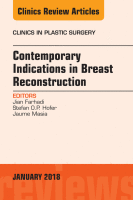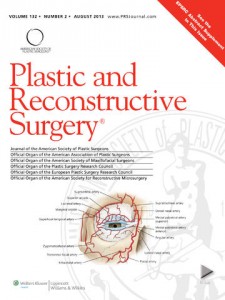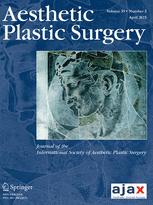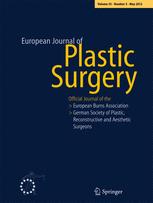Delay, E; Guerid, S; Meruta, A. C.
Clinics in Plastic Surgery, 2018-01-01, Volumen 45, Número 1, Páginas 101-110
 The treatment of sequelae after conservative breast cancer treatment can be a challenge. Lipomodeling, although controversial in the beginning, is a safe technique that can help in the treatment of these deformities, without an important impact on the imaging surveillance. Depending on the severity of the deformity, one or several sessions of fat transfer can be required.
The treatment of sequelae after conservative breast cancer treatment can be a challenge. Lipomodeling, although controversial in the beginning, is a safe technique that can help in the treatment of these deformities, without an important impact on the imaging surveillance. Depending on the severity of the deformity, one or several sessions of fat transfer can be required.
 El cáncer de piel afecta con frecuencia la región facial por su alta exposición a la radiación ultravioleta. La mejilla es un sitio frecuente y como consecuencia de la exéresis, quedan amplios defectos que requieren de técnicas reconstructivas. En el presente estudio se realizó un estudio prospectivo en 27 pacientes atendidas en el Instituto Nacional de Oncología y Radiobiología desde julio de 2013 hasta julio de 2015.
El cáncer de piel afecta con frecuencia la región facial por su alta exposición a la radiación ultravioleta. La mejilla es un sitio frecuente y como consecuencia de la exéresis, quedan amplios defectos que requieren de técnicas reconstructivas. En el presente estudio se realizó un estudio prospectivo en 27 pacientes atendidas en el Instituto Nacional de Oncología y Radiobiología desde julio de 2013 hasta julio de 2015. El cáncer de mama es el cáncer más frecuente en las mujeres en todo el mundo y es la principal causa de muerte por cáncer entre las mujeres. La mastectomía profiláctica o curativa a menudo está seguida por la reconstrucción de la mama, por lo que existen varios enfoques quirúrgicos que utilizan implantes de mama con los que los cirujanos pueden restaurar la apariencia, el tamaño y la forma natural de la mama. El objetivo de este trabajo fue evaluar los efectos de diferentes tipos de implantes de mama sobre la contractura capsular, las complicaciones quirúrgicas a corto y a largo plazo, el nivel de satisfacción posoperatoria y la calidad de vida en las pacientes sometidas al proceder.
El cáncer de mama es el cáncer más frecuente en las mujeres en todo el mundo y es la principal causa de muerte por cáncer entre las mujeres. La mastectomía profiláctica o curativa a menudo está seguida por la reconstrucción de la mama, por lo que existen varios enfoques quirúrgicos que utilizan implantes de mama con los que los cirujanos pueden restaurar la apariencia, el tamaño y la forma natural de la mama. El objetivo de este trabajo fue evaluar los efectos de diferentes tipos de implantes de mama sobre la contractura capsular, las complicaciones quirúrgicas a corto y a largo plazo, el nivel de satisfacción posoperatoria y la calidad de vida en las pacientes sometidas al proceder. Resection of facial skin tumors aims to remove the tumors completely and make the surgical scar unnoticeable as much as possible. By improving the purse string suture method, we developed a new pentagram suture technique that enables simple and safe suturing of small to large defects with early satisfactory esthetic outcomes. The surgical outcomes of a case series were examined in this report.
Resection of facial skin tumors aims to remove the tumors completely and make the surgical scar unnoticeable as much as possible. By improving the purse string suture method, we developed a new pentagram suture technique that enables simple and safe suturing of small to large defects with early satisfactory esthetic outcomes. The surgical outcomes of a case series were examined in this report.
 As close as the buttocks and the perineum are anatomically, the clinical settings and the solutions to wound problems in these areas are quite different. The ubiquitous “pressure ulcer” presents more commonly as a clinical management problem than a reconstruction issue. On the other hand, the perineal defect is almost always a reconstruction challenge following tumor ablation. For these reasons, the authors have chosen to separate this Continuing Medical Education offering into two parts. The first part addresses the pressure ulcer, while the latter discusses the perineum.
As close as the buttocks and the perineum are anatomically, the clinical settings and the solutions to wound problems in these areas are quite different. The ubiquitous “pressure ulcer” presents more commonly as a clinical management problem than a reconstruction issue. On the other hand, the perineal defect is almost always a reconstruction challenge following tumor ablation. For these reasons, the authors have chosen to separate this Continuing Medical Education offering into two parts. The first part addresses the pressure ulcer, while the latter discusses the perineum. Fingertip reconstruction using reverse-flow homodigital island flaps has been very popular over the years. However, the outcomes of reconstruction have not been clearly understood. In these circumstances, a systematic review of available literature is warranted. A PubMed [MEDLINE] electronic database was searched (1985 to 15 April 2015).
Fingertip reconstruction using reverse-flow homodigital island flaps has been very popular over the years. However, the outcomes of reconstruction have not been clearly understood. In these circumstances, a systematic review of available literature is warranted. A PubMed [MEDLINE] electronic database was searched (1985 to 15 April 2015). Local skin flaps are used to close defects adjacent to the donor site. They are classified according to their method of movement: flaps that advance from its base to the defect (V-Y, Y-V, single-pedicle, and bipedicle advancement flaps) and flaps that move on a pivot point (rotation, transposition, and interpolation flaps). Despite its frequent use, there is not a unique name for V-Y rotation advancement flap; moreover, there is not a flap class called “rotation advancement” in the textbooks. A systematic review of the literature was conducted using “PubMed” and “Google Scholar” in December 2013.
Local skin flaps are used to close defects adjacent to the donor site. They are classified according to their method of movement: flaps that advance from its base to the defect (V-Y, Y-V, single-pedicle, and bipedicle advancement flaps) and flaps that move on a pivot point (rotation, transposition, and interpolation flaps). Despite its frequent use, there is not a unique name for V-Y rotation advancement flap; moreover, there is not a flap class called “rotation advancement” in the textbooks. A systematic review of the literature was conducted using “PubMed” and “Google Scholar” in December 2013.






 Sitio web publicado el
Sitio web publicado el
Los lectores comentan